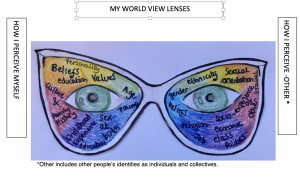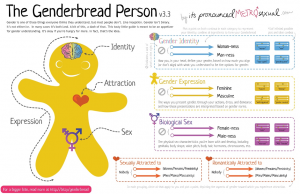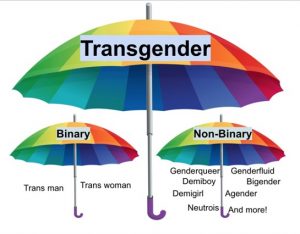Body, Gender, and Sexual Orientation: How We Identify Ourselves and How Our Identities Can Change Over a Lifetime
As part of our Passage Connect events, we were very grateful when Centre LGBTIQ+ Cigale agreed to help us understand the complex subject of ‘identity’ that is crucial to our relationship with our children and the young people we care for as professionals. This is such an important and complex subject that we have decided to split the discussion between two articles. In part one, I will give an overview of our discussion concerning ‘identity’ and an introduction to what it means to identify as LGBTIQ+. In part two, I will give some practical suggestions of how to talk about this subject with children or adolescents and the services that Centre LGBTIQ+ Cigale provides in Luxembourg.
How Body, Gender and Sexual Orientation forms part of our Identity
Identity is a very complex idea that is in itself fluid and has many components, which means that it changes depending on different circumstances, contexts, cultures, times in a person’s life, and history itself. The way we identify ourselves is unique because it is so dependent on our relationship with ourselves and other people which is also changing all the time. Added to this it is widely accepted that we are living in a world wherein in real terms there are no fixed boxes we all fit into anymore. This idea can be very challenging, especially to the older generation who were socialized to believe in fixed binary boxes like boy/girl. Basically, you were either /or and there was little or nothing in between. Our understanding of human beings has changed dramatically over the last 30 years with developments in psychology, sociology, and neuroscience, and scientists today within these fields are much more inclined to describe the various ways in which we might identify ourselves as spectrums rather than in binary terms. These spectrums form, at any time, only a part of our multi-faceted identity and we should never be reduced to only one part of our identity.
Our identity may also be assigned to us, attributed, or claimed. An example of this is that a baby is born and has the sexual organs assigned to the gender identity of ‘boy’ this is then their assigned gender identity. However, the person who is assigned this label may identify more as a ‘girl’ and this is their claimed identity. People may see this person as a ‘boy’ or a ‘girl’ depending on t heir own view of these identities, and this is the attributed identity of the person. In this way, we can understand that the way we all perceive identity is dependent on the way we interpret the world through our own metaphorical lenses or our worldview. Which is unique and changing all the time with new information and experience. Problems arise when we do not recognize that everyone interprets their experience of the world through their own worldview lenses therefore no two people will have the same point of view. That is why we need to respect how other people identify themselves.
heir own view of these identities, and this is the attributed identity of the person. In this way, we can understand that the way we all perceive identity is dependent on the way we interpret the world through our own metaphorical lenses or our worldview. Which is unique and changing all the time with new information and experience. Problems arise when we do not recognize that everyone interprets their experience of the world through their own worldview lenses therefore no two people will have the same point of view. That is why we need to respect how other people identify themselves.
So, what does our Sex, Gender and Sexual Orientation mean?
Part of our identity often includes our Sex, Gender, and Sexual Orientation. However, many of us find these labels confusing which can lead to misunderstanding and frustration. Sex in this context is taken as meaning the sexual characteristics we were born with i.e. male and/or female genitalia. But it also includes the predominant mix of hormones and/or chromosomes. When explaining this we use the spectrum from Male to Female showing that it is possible to have a level of these characteristics higher at either end of the spectrum or in the middle. The middle range of this spectrum is known as Intersex. Around 2% of the population of Luxembourg are born and identified as Intersex every year. These people may be born with sexual characteristics of Male and Female including genitalia , or a different chromosomes make-up. Later in life a person may develop a higher level of hormones associated with being traditionally Male or Female and this may change the way they identify themselves.
Gender
Gender again is traditionally seen as a spectrum between Male and Female although this is changing. It could be said that our Gender is what we are attributed to by the society we live in. Gender is the box we generally tick on official documents. But Gender can also be visualized as a spectrum between Male and Female. Within or without this spectrum, a person may identify as Transgender. A person may identify as transgender if their gender identity does not match the sexual characteristics they were born with and therefore the gender they were assigned at birth. For example, if they were born with a female body but identify as a man, they are a transgender man. Transgender people can be very binary. It is an umbrella term for all identities that are not cis-gender (meaning that they identify with the gender that was assigned to them at birth), which also includes non-binary identities. As the word says, these are people who do not fit into the binary man-woman system. One non-binary identity is genderfluid, meaning that your gender may change depending on time and context. Others may just not feel 100% man or woman but somewhere in between or outside of these categories.
Sexual Orientation
Sexual orientation is more about whom we are attracted to in a sexual and non-sexual way as a partner. On this spectrum, Heterosexuals are attracted to the opposite sex or gender and Homosexuals are attracted to the same sex or gender. In between as you can see in the graphic a person can identify as Bi-sexual people who may feel attracted to two genders (“bi” meaning “two”) which does not automatically exclude transgender people and pansexual people who do not care about the person’s gender (“pan” meaning “all”). Sexual orientation also includes people who identify as Asexual and/or Aromantic. Asexual people may be romantically attracted to someone but they experience no or very little sexual attraction. Aromantic people may want to have sex but they are generally not interested in a romantic relationship
A person may identify with one or several different identities throughout their lives. It is important to note that a person’s sex, gender, or sexual orientation is just a part of who they are which we have already said is multi – dimensional.
What does LGBTIQ+ mean?
Every June 28, the world celebrates sexual and gender diversity, a reality that is reflected in each of the letters and symbols of the acronym that defines this community. All these identities are covered by what we have discussed above. The L = Lesbian G= Gay B= Bisexual T=Transgender I = Intersex Q= Queer +. Queer and + is the part of the acronym that represents an umbrella term for both any person who identifies with the LGBTIQ+ community and the fact that people have a right to define themselves or take on identities of their choosing. For the LGBTIQ+ community, inclusion is of the utmost importance.
Why is it important for parents and professionals to be open to talking about this with young people?
In many countries, including Luxembourg, there is an increasing openness to talk about these different identities amongst young people. Children as young as primary school age are discussing this subject in the playground and more parents are looking to find out information about how to discuss issues around gender, sex, and sexuality. In part two, of this overview of our Passage Connect information evening with Centre LGBTIQ+ Cigale
I will discuss the suggestions given to start and shape these conversations with children and adolescents.
Our thanks to Mylene and Elsa from Centre LGBTIQ+ Cigale in Luxembourg for giving us such an interesting and helpful overview of this subject . Please do contact this service if you have any more questions, need advice, or just want to chat about anything we have covered in this article.
CIGALE Centre LGBTIQ+
16 Rue Notre-Dame (2nd floor)
L-2240, Luxembourg


